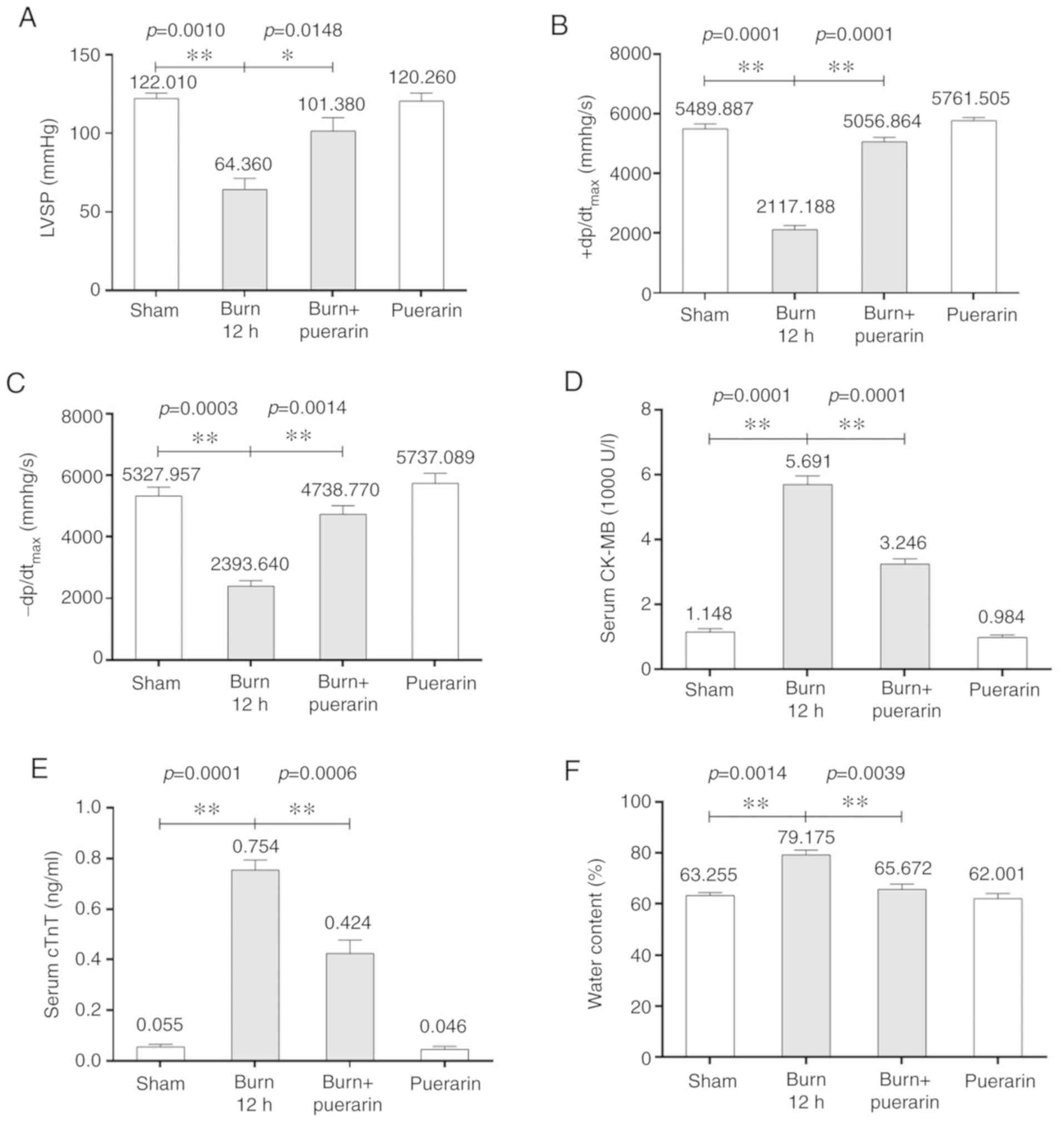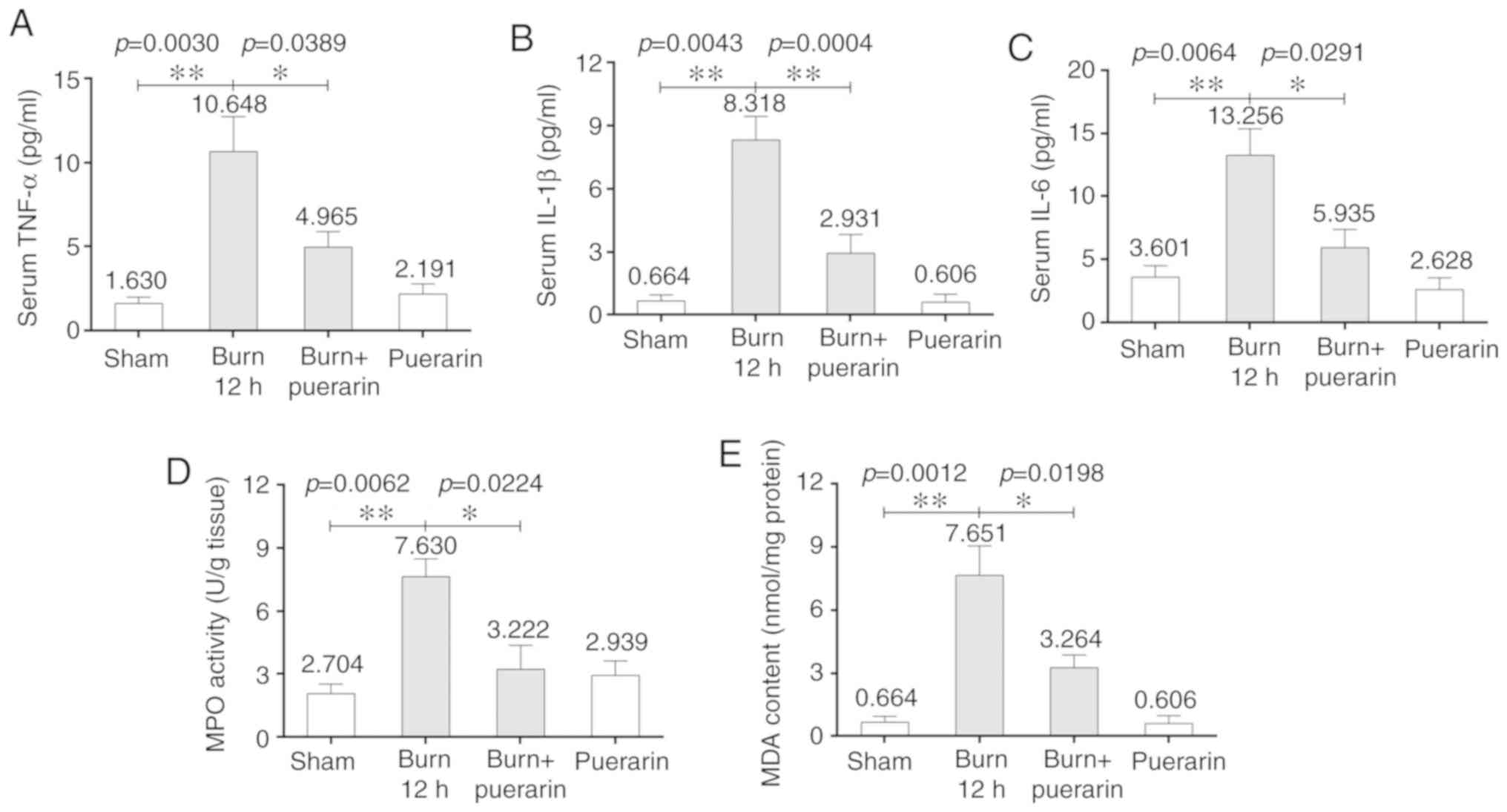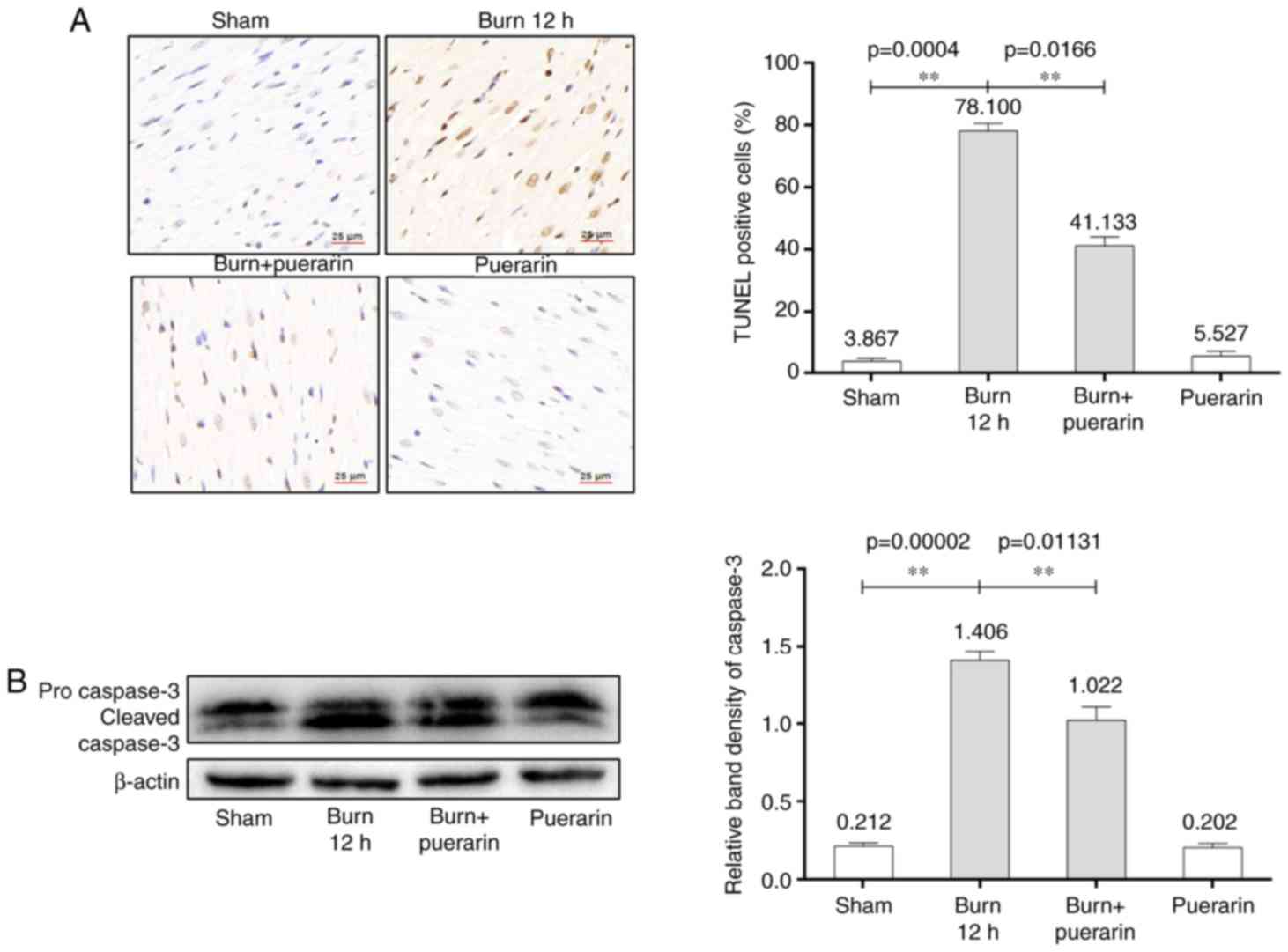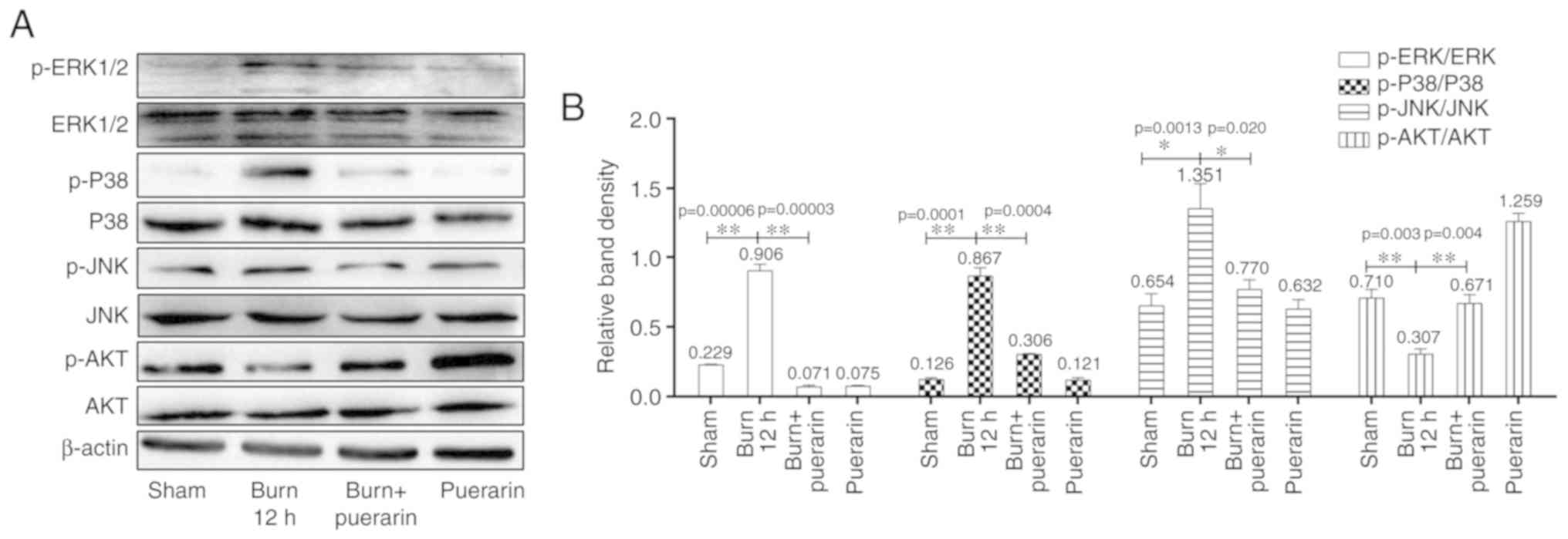|
1
|
Soussi S, Dépret F, Benyamina M and
Legrand M: Early Hemodynamic Management of Critically Ill Burn
Patients. Anesthesiology. 129:583–589. 2018.PubMed/NCBI View Article : Google Scholar
|
|
2
|
Guillory AN, Clayton RP, Herndon DN and
Finnerty CC: Cardiovascular Dysfunction Following Burn Injury: What
We Have Learned from Rat and Mouse Models. Int J Mol Sci.
17(53)2016.PubMed/NCBI View Article : Google Scholar
|
|
3
|
Horton JW, Maass DL, White DJ, Sanders B
and Murphy J: Effects of burn serum on myocardial inflammation and
function. Shock. 22:438–445. 2004.PubMed/NCBI View Article : Google Scholar
|
|
4
|
Fozzard HA: Myocardial injury in burn
shock. Ann Surg. 154:113–119. 1961.PubMed/NCBI View Article : Google Scholar
|
|
5
|
Zhang DX, Yan H, Hu JY, Zhang JP, Teng M,
Tong DL, Xiang F, Zhang Q, Fang YD, Liang GP, et al: Identification
of mitochondria translation elongation factor Tu as a contributor
to oxidative damage of postburn myocardium. J Proteomics.
77:469–479. 2012.PubMed/NCBI View Article : Google Scholar
|
|
6
|
Meldrum DR, Wang M, Tsai BM, Kher A,
Pitcher JM, Brown JW and Meldrum KK: Intracellular signaling
mechanisms of sex hormones in acute myocardial inflammation and
injury. Front Biosci. 10:1835–1867. 2005.PubMed/NCBI View
Article : Google Scholar
|
|
7
|
Horton JW, Maass DL and Ballard-Croft C:
Rho-associated kinase modulates myocardial inflammatory cytokine
responses. Shock. 24:53–58. 2005.PubMed/NCBI View Article : Google Scholar
|
|
8
|
Zhang Z, Zhang Y, Deng Y, Li S, Zhou W,
Yang C, Xu X and Li T: Polymerized human placenta haemoglobin
attenuates myocardial injury and aortic endothelial dysfunction in
a rat model of severe burns. Artif Cells Nanomed Biotechnol.
46:1141–1145. 2018.PubMed/NCBI View Article : Google Scholar
|
|
9
|
Prasain JK, Jones K, Kirk M, Wilson L,
Smith-Johnson M, Weaver C and Barnes S: Profiling and
quantification of isoflavonoids in kudzu dietary supplements by
high-performance liquid chromatography and electrospray ionization
tandem mass spectrometry. J Agric Food Chem. 51:4213–4218.
2003.PubMed/NCBI View Article : Google Scholar
|
|
10
|
Wong KH, Li GQ, Li KM, Razmovski-Naumovski
V and Chan K: Kudzu root: Traditional uses and potential medicinal
benefits in diabetes and cardiovascular diseases. J Ethnopharmacol.
134:584–607. 2011.PubMed/NCBI View Article : Google Scholar
|
|
11
|
Yan LP, Chan SW, Chan AS, Chen SL, Ma XJ
and Xu HX: Puerarin decreases serum total cholesterol and enhances
thoracic aorta endothelial nitric oxide synthase expression in
diet-induced hypercholesterolemic rats. Life Sci. 79:324–330.
2006.PubMed/NCBI View Article : Google Scholar
|
|
12
|
Pan ZY, Bao ZS, Wu ZM, Wang XM, Zheng JZ,
Shen YL and Zhang XM: The myocardial protective effects of puerarin
on STZ-induced diabetic rats. Fen Zi Xi Bao Sheng Wu Xue Bao.
42:137–144. 2009.PubMed/NCBI
|
|
13
|
Lin F, Xie B, Cai F and Wu G: Protective
effect of Puerarin on β-amyloid-induced neurotoxicity in rat
hippocampal neurons. Arzneimittelforschung. 62:187–193.
2012.PubMed/NCBI View Article : Google Scholar
|
|
14
|
Zhao M, Du YQ, Yuan L and Wang NN:
Protective effect of puerarin on acute alcoholic liver injury. Am J
Chin Med. 38:241–249. 2010.PubMed/NCBI View Article : Google Scholar
|
|
15
|
Wong R and Rabie B: Effect of puerarin on
bone formation. Osteoarthritis Cartilage. 15:894–899.
2007.PubMed/NCBI View Article : Google Scholar
|
|
16
|
Xiao C, Li J, Dong X, et al:
Anti-oxidative and TNF-alpha suppressive activities of puerarin
derivative (4AC) in RAW264.7 cells and collagen-induced arthritic
rats. Eur J Pharmacol. 666:242–250. 2011.PubMed/NCBI View Article : Google Scholar
|
|
17
|
Zhou YX, Zhang H and Peng C: Puerarin: a
review of pharmacological effects. Phytother Res. 28:961–975.
2014.PubMed/NCBI View
Article : Google Scholar
|
|
18
|
Hwang YP and Jeong HG: Mechanism of
phytoestrogen puerarin-mediated cytoprotection following oxidative
injury: Estrogen receptor-dependent up-regulation of PI3K/Akt and
HO-1. Toxicol Appl Pharmacol. 233:371–381. 2008.PubMed/NCBI View Article : Google Scholar
|
|
19
|
Hou SZ, Su ZR, Chen SX, Ye MR, Huang S,
Liu L, Zhou H and Lai XP: Role of the interaction between puerarin
and the erythrocyte membrane in puerarin-induced hemolysis. Chem
Biol Interact. 192:184–192. 2011.PubMed/NCBI View Article : Google Scholar
|
|
20
|
Xiao LZ, Gao LJ and Ma SC: Comparative
study on effects of puerarin and granulocyte colony-stimulating
factor in treating acute myocardial infarction. Zhongguo Zhong Xi
Yi Jie He Za Zhi. 25(210)2005.(In Chinese). PubMed/NCBI
|
|
21
|
Fan LL, Sun LH, Li J, Yue XH, Yu HX and
Wang SY: The protective effect of puerarin against myocardial
reperfusion injury. Study on cardiac function. Chin Med J (Engl).
105:11–17. 1992.PubMed/NCBI
|
|
22
|
Wu L, Qiao H, Li Y and Li L: Protective
roles of puerarin and Danshensu on acute ischemic myocardial injury
in rats. Phytomedicine. 14:652–658. 2007.PubMed/NCBI View Article : Google Scholar
|
|
23
|
Feng ZQ, Wang YY, Guo ZR, Chu FM and Sun
PY: The synthesis of puerarin derivatives and their protective
effect on the myocardial ischemia and reperfusion injury. J Asian
Nat Prod Res. 12:843–850. 2010.PubMed/NCBI View Article : Google Scholar
|
|
24
|
Sun XH, Ding JP, Li H, Pan N, Gan L, Yang
XL and Xu HB: Activation of large-conductance calcium-activated
potassium channels by puerarin: The underlying mechanism of
puerarin-mediated vasodilation. J Pharmacol Exp Ther. 323:391–397.
2007.PubMed/NCBI View Article : Google Scholar
|
|
25
|
Wattanapitayakul SK and Bauer JA:
Oxidative pathways in cardiovascular disease: Roles, mechanisms,
and therapeutic implications. Pharmacol Ther. 89:187–206.
2001.PubMed/NCBI View Article : Google Scholar
|
|
26
|
Yuan Y, Zong J, Zhou H, Bian ZY, Deng W,
Dai J, Gan HW, Yang Z, Li H and Tang QZ: Puerarin attenuates
pressure overload-induced cardiac hypertrophy. J Cardiol. 63:73–81.
2014.PubMed/NCBI View Article : Google Scholar
|
|
27
|
Gao L, Ji X, Song J, Liu P, Yan F, Gong W,
Dang S and Luo Y: Puerarin protects against ischemic brain injury
in a rat model of transient focal ischemia. Neurol Res. 31:402–406.
2009.PubMed/NCBI View Article : Google Scholar
|
|
28
|
National Research Council (US) Institute
for Laboratory Animal Research. Guide for the Care and Use of
Laboratory Animals. National Academies Press (US), Washington, DC.
1996.PubMed/NCBI
|
|
29
|
Korompai FL and Yuan SY: Ventral burn in
rats: An experimental model for intravital microscopic study of
microcirculation. Burns. 28:321–327. 2002.PubMed/NCBI View Article : Google Scholar
|
|
30
|
Hernekamp JF, Hu S, Schmidt K, Walther A,
Lehnhardt M and Kremer T: Methysergide attenuates systemic burn
edema in rats. Microvasc Res. 89:115–121. 2013.PubMed/NCBI View Article : Google Scholar
|
|
31
|
Liu S, Ren HB, Chen XL, Wang F, Wang RS,
Zhou B, Wang C, Sun YX and Wang YJ: Puerarin attenuates severe
burn-induced acute myocardial injury in rats. Burns. 41:1748–1757.
2015.PubMed/NCBI View Article : Google Scholar
|
|
32
|
Matos VSB, Gomes FDS, Oliveira TM, Schulz
RDS, Ribeiro LCV, Gonzales ADF, Lima JM and Guerreiro MLDS: Effects
of emissions from sugar cane burning on the trachea and lungs of
Wistar rats. J Bras Pneumol. 43:208–214. 2017.PubMed/NCBI View Article : Google Scholar
|
|
33
|
Yao X, Wigginton JG, Maass DL, Ma L,
Carlson D, Wolf SE, Minei JP and Zang QS: Estrogen-provided cardiac
protection following burn trauma is mediated through a reduction in
mitochondria-derived DAMPs. Am J Physiol Heart Circ Physiol.
306(H882-H894)2014.PubMed/NCBI View Article : Google Scholar
|
|
34
|
Wang J, Zhang T, Ma C and Wang S: Puerarin
attenuates airway inflammation by regulation of eotaxin-3. Immunol
Lett. 163:173–178. 2015.PubMed/NCBI View Article : Google Scholar
|
|
35
|
Liu CM, Ma JQ, Liu SS, Feng ZJ and Wang
AM: Puerarin protects mouse liver against nickel-induced oxidative
stress and inflammation associated with the TLR4/p38/CREB pathway.
Chem Biol Interact. 243:29–34. 2016.PubMed/NCBI View Article : Google Scholar
|
|
36
|
França LFC, Vasconcelos ACCG, da Silva
FRP, Alves EHP, Carvalho JS, Lenardo DD, de Souza LKM, Barbosa ALR,
Medeiros JR, de Oliveira JS, et al: Periodontitis changes renal
structures by oxidative stress and lipid peroxidation. J Clin
Periodontol. 44:568–576. 2017.PubMed/NCBI View Article : Google Scholar
|
|
37
|
Zhang JP, Ying X, Liang WY, Luo ZH, Yang
ZC, Huang YS and Wang WC: Apoptosis in cardiac myocytes during the
early stage after severe burn. J Trauma. 65:401–408; discussion
408. 2008.PubMed/NCBI View Article : Google Scholar
|
|
38
|
Lv GF, Dong ML, Hu DH, Zhang WF, Wang YC,
Tang CW and Zhu XX: Insulin-mediated inhibition of p38
mitogen-activated protein kinase protects cardiomyocytes in severe
burns. J Burn Care Res. 32:591–599. 2011.PubMed/NCBI View Article : Google Scholar
|
|
39
|
Huang Y, Zheng J, Fan P and Zhang X:
Transfection of antisense p38 alpha gene ameliorates myocardial
cell injury mediated by hypoxia and burn serum. Burns. 33:599–605.
2007.PubMed/NCBI View Article : Google Scholar
|
|
40
|
Huang YS: Autophagy and hypoxic ischemic
myocardial damage after severe burn. Zhonghua Shao Shang Za Zhi.
34:3–7. 2018.(In Chinese). PubMed/NCBI View Article : Google Scholar
|
|
41
|
Carr AC, McCall MR and Frei B: Oxidation
of LDL by myeloperoxidase and reactive nitrogen species: Reaction
pathways and antioxidant protection. Arterioscler Thromb Vasc Biol.
20:1716–1723. 2000.PubMed/NCBI View Article : Google Scholar
|
|
42
|
Zhang R, Brennan ML, Fu X, Aviles RJ,
Pearce GL, Penn MS, Topol EJ, Sprecher DL and Hazen SL: Association
between myeloperoxidase levels and risk of coronary artery disease.
JAMA. 286:2136–2142. 2001.PubMed/NCBI View Article : Google Scholar
|
|
43
|
Eiserich JP, Baldus S, Brennan ML, Ma W,
Zhang C, Tousson A, Castro L, Lusis AJ, Nauseef WM, White CR, et
al: Myeloperoxidase, a leukocyte-derived vascular NO oxidase.
Science. 296:2391–2394. 2002.PubMed/NCBI View Article : Google Scholar
|
|
44
|
Posa A, Szabó R, Kupai K, Berkó AM,
Veszelka M, Szűcs G, Börzsei D, Gyöngyösi M, Pávó I, Deim Z, et al:
Cardioprotective Effect of Selective Estrogen Receptor Modulator
Raloxifene Are Mediated by Heme Oxygenase in Estrogen-Deficient
Rat. Oxid Med Cell Longev. 2017(2176749)2017.PubMed/NCBI View Article : Google Scholar
|
|
45
|
Posa A, Pavo N, Hemetsberger R, Csonka C,
Csont T, Ferdinandy P, Petrási Z, Varga C, Pavo IJ, Laszlo F Jr, et
al: Protective effect of ischaemic preconditioning on
ischaemia/reperfusion-induced microvascular obstruction determined
by on-line measurements of coronary pressure and blood flow in
pigs. Thromb Haemost. 103:450–460. 2010.PubMed/NCBI View Article : Google Scholar
|
|
46
|
Covelli V, Munno I, Pellegrino NM, Di
Venere A, Jirillo E and Buscaino GA: Exaggerated spontaneous
release of tumor necrosis factor-alpha/cachectin in patients with
migraine without aura. Acta Neurol (Napoli). 12:257–263.
1990.PubMed/NCBI
|
|
47
|
Covelli V, Munno I, Pellegrino NM,
Altamura M, Decandia P, Marcuccio C, Di Venere A and Jirillo E: Are
TNF-alpha and IL-1 beta relevant in the pathogenesis of migraine
without aura? Acta Neurol (Napoli). 13:205–211. 1991.PubMed/NCBI
|
|
48
|
Rietschel ET, Schletter J, Weidemann B,
El-Samalouti V, Mattern T, Zähringer U, Seydel U, Brade H, Flad HD,
Kusumoto S, et al: Lipopolysaccharide and peptidoglycan:
CD14-dependent bacterial inducers of inflammation. Microb Drug
Resist. 4:37–44. 1998.PubMed/NCBI View Article : Google Scholar
|
|
49
|
Maass DL, White J and Horton JW: IL-1beta
and IL-6 act synergistically with TNF-alpha to alter cardiac
contractile function after burn trauma. Shock. 18:360–366.
2002.PubMed/NCBI View Article : Google Scholar
|
|
50
|
Liu XJ, Zhao J and Gu XY: The effects of
genistein and puerarin on the activation of nuclear factor-kappaB
and the production of tumor necrosis factor-alpha in asthma
patients. Pharmazie. 65:127–131. 2010.PubMed/NCBI
|
|
51
|
Goldmann BU, Rudolph V, Rudolph TK, Holle
AK, Hillebrandt M, Meinertz T and Baldus S: Neutrophil activation
precedes myocardial injury in patients with acute myocardial
infarction. Free Radic Biol Med. 47:79–83. 2009.PubMed/NCBI View Article : Google Scholar
|
|
52
|
Yang Y, Duan W, Jin Z, Yi W, Yan J, Zhang
S, Wang N, Liang Z, Li Y, Chen W, et al: JAK2/STAT3 activation by
melatonin attenuates the mitochondrial oxidative damage induced by
myocardial ischemia/reperfusion injury. J Pineal Res. 55:275–286.
2013.PubMed/NCBI View Article : Google Scholar
|
|
53
|
Grütter MG: Caspases: Key players in
programmed cell death. Curr Opin Struct Biol. 10:649–655.
2000.PubMed/NCBI View Article : Google Scholar
|
|
54
|
Zhang Y, Yang X, Ge X and Zhang F:
Puerarin attenuates neurological deficits via Bcl-2/Bax/cleaved
caspase-3 and Sirt3/SOD2 apoptotic pathways in subarachnoid
hemorrhage mice. Biomed Pharmacother. 109:726–733. 2019.PubMed/NCBI View Article : Google Scholar
|
|
55
|
De Zutter GS and Davis RJ: Pro-apoptotic
gene expression mediated by the p38 mitogen-activated protein
kinase signal transduction pathway. Proc Natl Acad Sci USA.
98:6168–6173. 2001.PubMed/NCBI View Article : Google Scholar
|
|
56
|
Saurin AT, Martin JL, Heads RJ, Foley C,
Mockridge JW, Wright MJ, Wang Y and Marber MS: The role of
differential activation of p38-mitogen-activated protein kinase in
preconditioned ventricular myocytes. FASEB J. 14:2237–2246.
2000.PubMed/NCBI View Article : Google Scholar
|


















